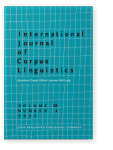Vol. 28:4 (2023) ► pp.559–585
Dative alternation in Chinese
A mixed-effects logistic regression analysis
This study investigates the factors significantly constraining dative alternation in Chinese by adopting mixed-effects logistic regression modelling. The analysis showed that such factors significantly affected the choice of dative variants in Chinese, including the animacy, pronominality, and definiteness of the recipient, the accessibility and concreteness of the theme, and the length difference between the theme and the recipient. Findings were compared with those for the English dative alternation discussed in the literature. When the theme was recoverable from context or shorter than the recipient, the prepositional dative construction was preferred in both English and Chinese. This can be explained by the principles of end-focus and end-weight. However, when the recipient was animate or definite, the double object construction was preferred in English, while the prepositional dative construction was more likely to be used in Chinese. This divergence is due to the different syntactic and semantic features of their recipient markers.
Article outline
- 1.Introduction
- 2.Previous studies on Chinese dative alternation
- 3.Data and methods
- 3.1The data
- 3.2Annotation of variables
- 3.2.1Explanatory variables
- 3.2.2Response variable (‘Dative’)
- 3.3Statistical modelling
- 4.Results
- 4.1Fixed effects
- 4.2Random effects
- 5.Discussion
- 6.Conclusion
- Acknowledgements
- Notes
-
References
